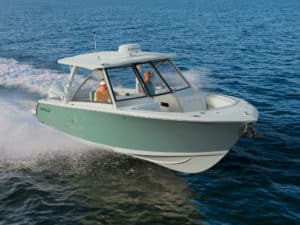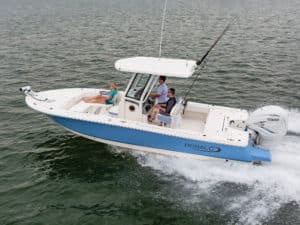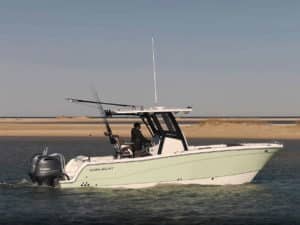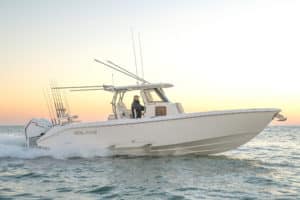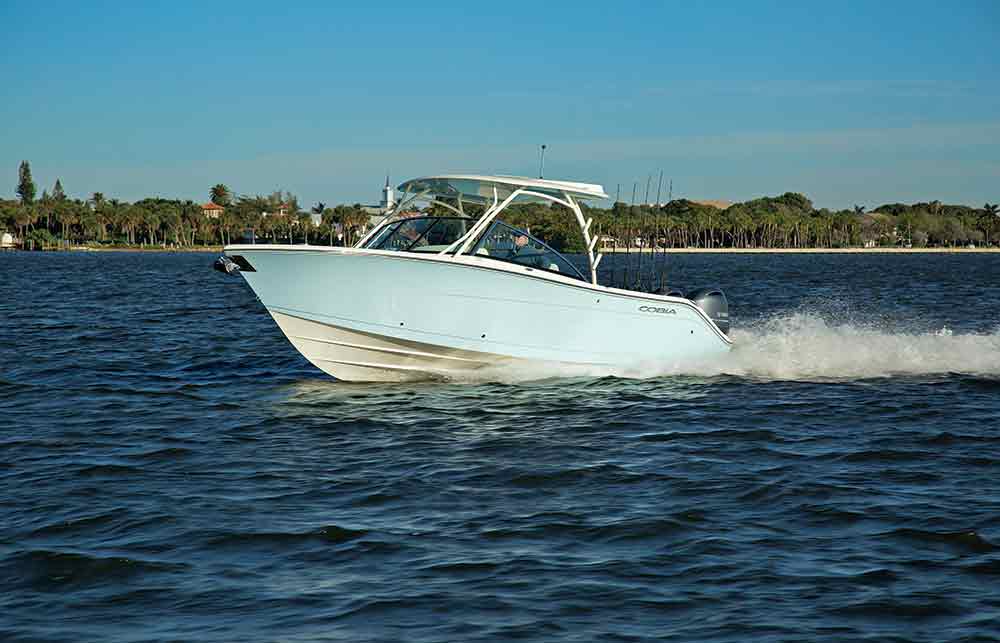
A freshening north wind pushed hard against the relentless Gulf Stream off Boynton Beach, Florida, as foam-streaked waves built to 4 feet. But the boat under my feet, Cobia’s new 280 Dual Console, provided a stable and secure platform as we trolled for mahimahi, sailfish and wahoo.
This Cobia impressed me with fishing features, plenty of deck space, comfort, and weather protection. Above all, the 280 Dual Console offers versatility for families who want to maximize their new-boat investment.
“It’s really a boat for families who want to enjoy just about everything on the water,” says Capt. Ryan Buel, who joined me and Sport Fishing videographer Christopher Balogh to see how well the 280 DC fishes. Buel also works for Marine Connection, the Cobia dealership in West Palm Beach.
With a 27-foot-7-inch length overall, the 21-degree deep-V hull of the Cobia 280 DC lets you safely venture outside the inlet in pursuit of fish, whether you’re dropping baits on a wreck for snapper and grouper, or trolling the edge of the Gulf Stream for bluewater species. A sharp entry smooths the ride in choppy seas.
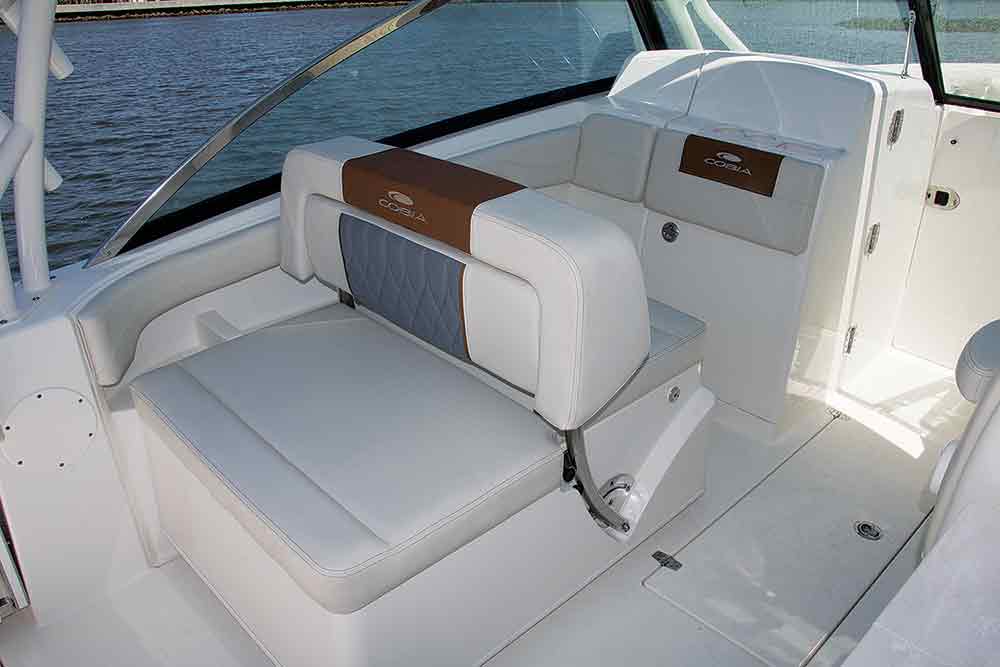
Advantages of a Dual-Console Boat
Earlier in the day, as we exited the Boynton Beach Inlet, it dawned on me that a dual-console layout can offer advantages over a center console. For one, the stainless-steel-framed tempered-glass windshield spans the width of the 280’s interior. With a door that closes off the pass-through to the bow, the full windshield protects the entire aft cockpit.
In addition, the consoles are positioned farther forward than on a similar-size center console, and that opens up more room astern. This, combined with a 9-foot-8-inch beam, gives the 280 DC an aft cockpit that measures 93 inches wide by 62 inches long, resulting in about 40 square feet of deck space.
That extra space is a wonderful area for entertaining, especially if you order the optional hideaway bench seats along both inwales. Add these to the standard foldout transom bench and optional aft dining table, as well as the wraparound bow seating, and you can host a large group.
The roomy cockpit gave Buel plenty of elbowroom as he deployed five trolling lines. As many as three crew members could easily work side by side. Below the deck is a pair of 41-gallon fish lockers.
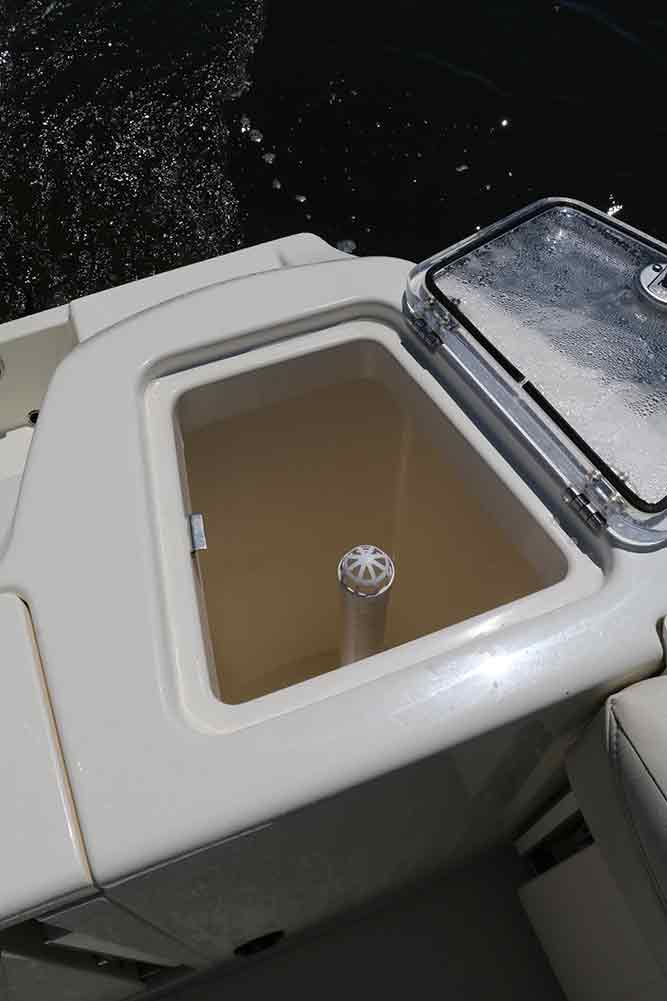
Livewell and Rod Holders
The wide beam also meant excellent stability, especially while trolling in the trough. The diamond nonskid sole assures traction, and padded coaming bolsters surrounding the aft cockpit help prevent bruised thighs.
Five flush-mount rod holders across the transom kept our sticks secure while underway, and also served as trolling-rod holders for the center flat line and lines fished from planers secured to the stainless-steel pull-up cleats on each stern corner. A 25-gallon livewell resides in the port quarter, and you’ll find a transom door in the starboard quarter.
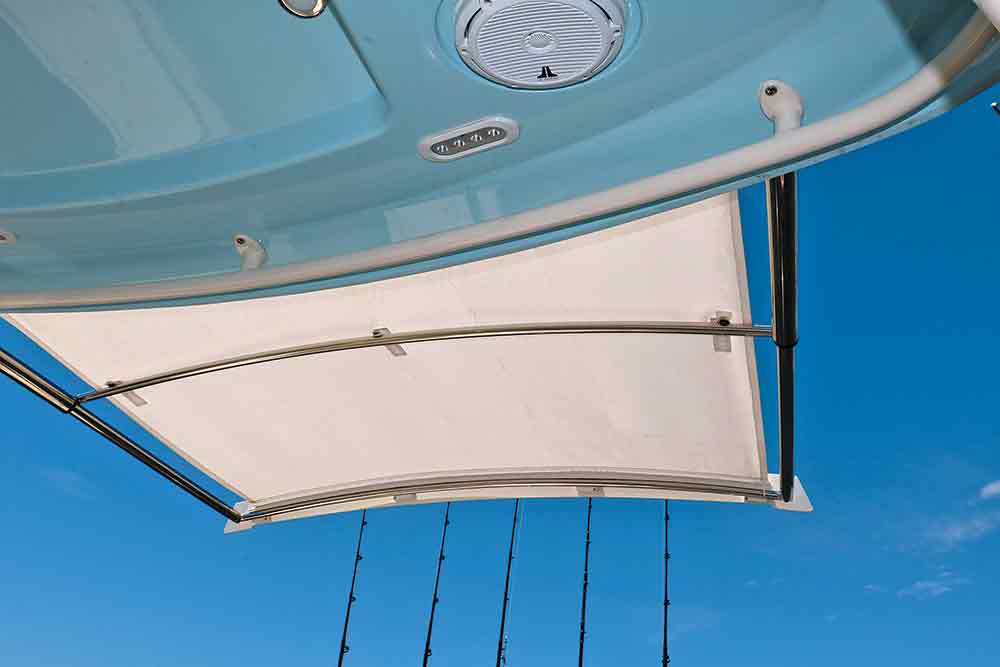
The 280 comes standard with gunwale rod holders — two on each side. But my test boat was equipped with the optional hideaway side bench seats, and these prevent the installation of gunwale rod holders. However, Cobia compensates for this by including three angled rod holders along the aft stanchions of the standard fiberglass hardtop. The lowest rod holders on each side served well for securing the rods for the two outside flat lines. The hardtop features spreader lights fore and aft, as well as bicolor (select blue or white with the flip of a toggle switch) dome lights.
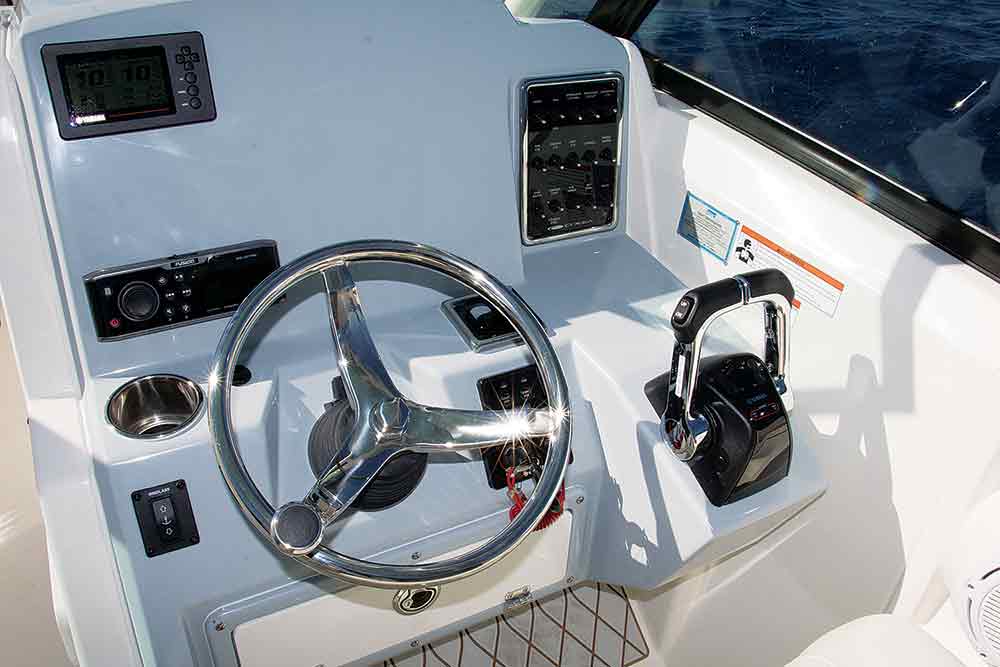
Comfortable Helm Seating
During my turn at the wheel, I found the helm seat particularly comfortable, whether seated and enjoying the angled footrest at the base of the starboard console or standing and using the flip-up bolster as a leaning post. My test boat featured the standard SeaStar Solutions hydraulic steering with a tilt-and-lock helm, but I recommend upgrading to the SeaStar Optimus power steering for easier control of the twin Yamaha F200 outboards.
My test boat was not equipped with electronics yet, but Buel recommends flush-mounting a 12-inch multifunction display, such as the Garmin GPSMap 7612xsv (available as a factory option), in order to make room for other instruments on the 22-inch-wide dash panel. A Garmin GMR 424 radar is available as a factory option in conjunction with the 7612xsv display.
I found the glove box just below the dash to be a handy place to stash truck keys, sunglasses cases and tubes of sunscreen. I also discovered stowage inside the starboard console, and this is where Balogh and I tucked away our camera and video gear.
With the trolling spread out, Buel took over at the helm while I explored further. The port seat converts quickly from a back-to-back configuration to a lounger that lies flat with the backrest swung forward — great for catching a nap under the shade of the hardtop. Underneath is a 145-quart cooler where we iced our drinks for the day.
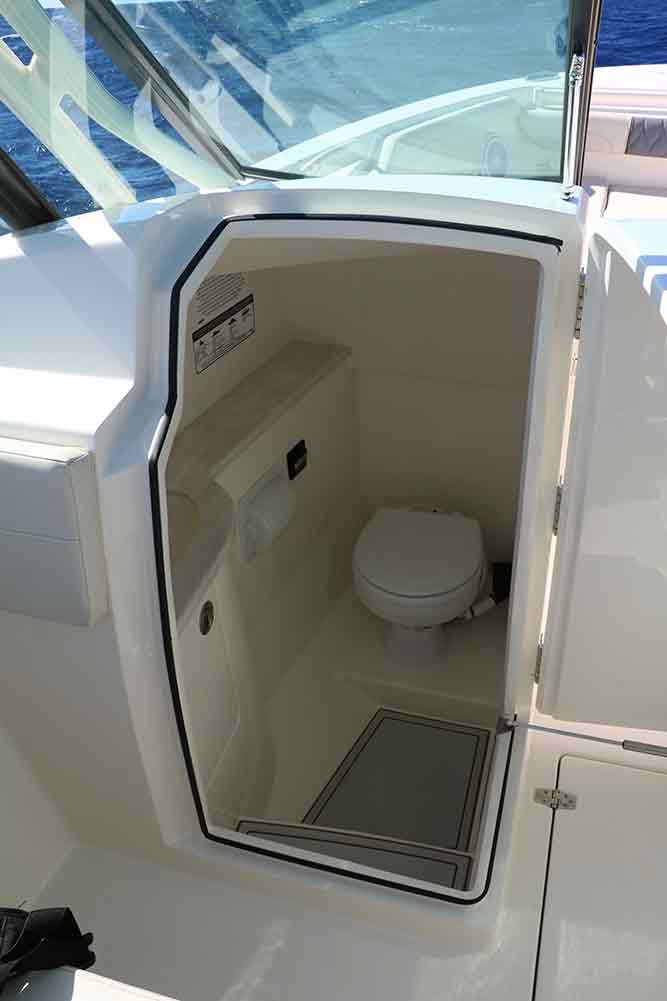
Luxury Features on Cobia 280 Dual Console
Inside the port console, I found a surprisingly roomy walk-down head compartment with an electric marine toilet, sink and freshwater faucet. Abaft the helm seat is a kitchenette. In standard form, it features a faux-granite countertop, sink, freshwater faucet, wine rack and cooler. My test boat featured the optional covered electric grill and fridge.
In the forepeak, I found two compartments. One houses the anchor locker with a Lewmar windlass, an in-stem chute with a roller, and a raw-water washdown hose. The second compartment houses a removable boarding ladder for the bow. It mounts in a pair of sockets, allowing crew to easily climb in and out when pulled up on a quiet shore.
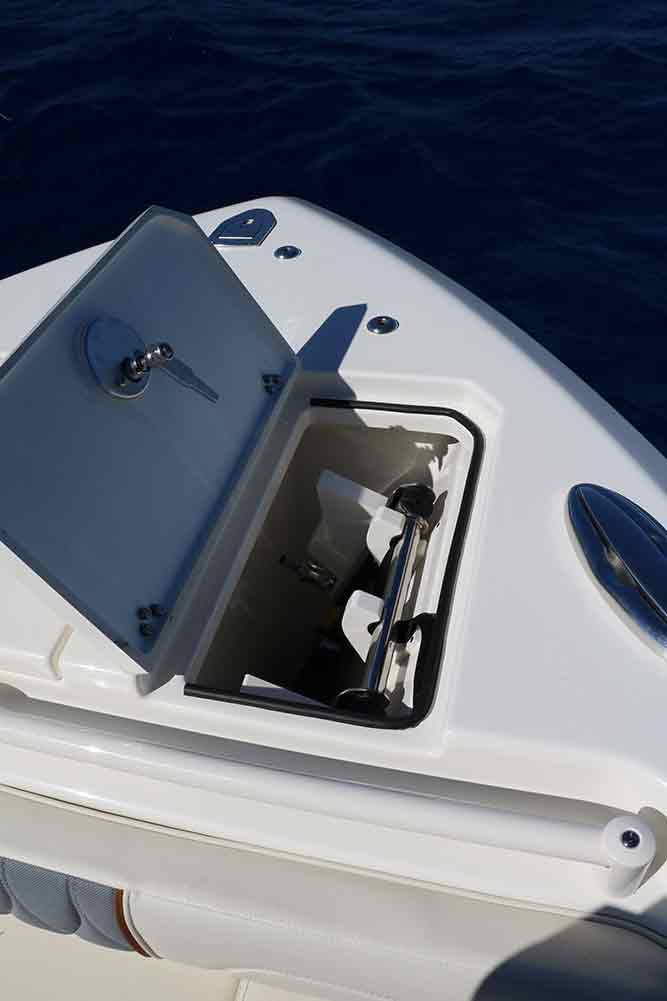
Just as I was finishing up my inspection, the clicker on the port flat line sounded the alarm. A sailfish was attacking the rigged mullet, but the hook failed to find a home. I raced back to grab the rod just as the sail batted at the bait again, but it didn’t eat it. The fish then darted toward the starboard bait and grabbed it too, but no hookup. The sail sank away, as did our hopes of a glory fish.
We trolled for two more hours without a bite, and by 11 a.m., the winds were gusting to 25 mph as the seas built to 6 feet. It was time to tack for home. That put the nose into the steep seas, but the bow refused to dip, instead rising nicely to crest each frothy wave top.
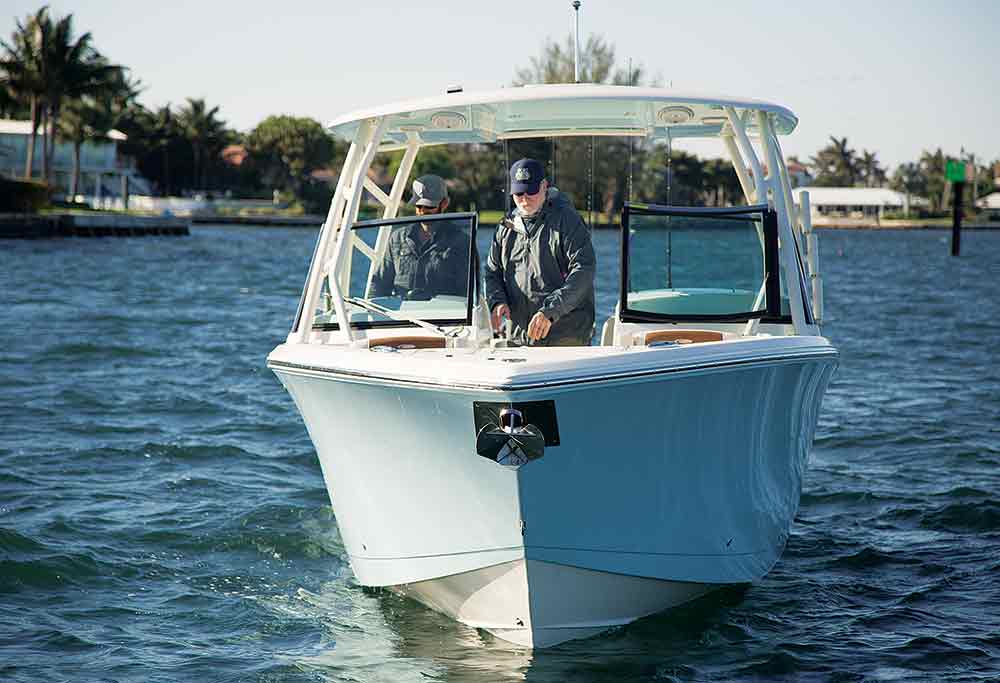
Boat-Performance Statistics
I collected performance data inside the calm waters of the Intracoastal Waterway. Equipped with 18-inch-pitch Reliance three-blade stainless-steel propellers, the twin F200s vaulted the 280 DC to plane in 4 seconds. It reached 30 mph in 9.5 seconds en route to a top speed of 49.5 mph at 5,700 rpm. Optimum fuel efficiency occurred at 4,500 rpm and 37 mph, where the twin 200s burned 18.4 gallons per hour for 2.01 mpg. That equates to a cruising range of more than 340 miles based on the 172-gallon fuel tank.
The Cobia 280 Dual Console fits nicely between hardcore fishing machines and pure pleasure craft by blending the features that offshore anglers want with the versatility and comfort that nonanglers crave — and it all rides on a stable, seaworthy hull that helps keep everyone aboard safe and secure.
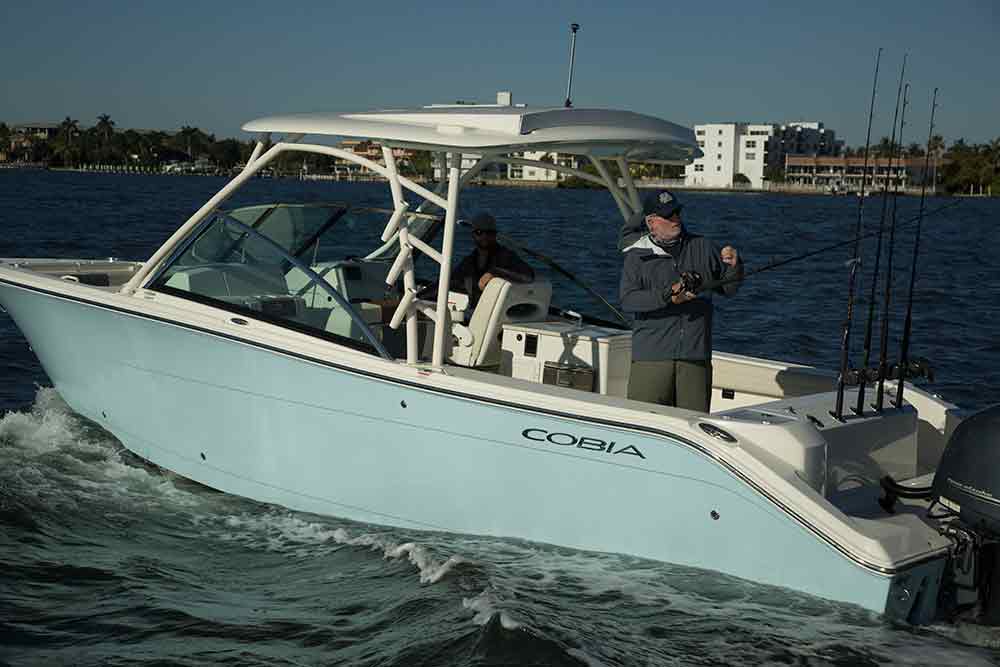
Cobia 280 Dual Console Review Specifications
Performance
Power: Twin Yamaha F200s
Load: 80 gal. fuel, three crew
Top Speed: 49.5 mph @ 5,700 rpm
Time to 30 mph: 9.5 sec.
Best MPG: 2.01 @ 37 mph (4,500 rpm)
Hull
LOA: 27 ft. 7 in.
Beam: 9 ft. 8 in.
Deadrise: 21 deg.
Dry Weight: 5,680 lb. (w/o engines)
Draft: 1 ft. 11 in.
Fuel: 172 gal.
Max Power: 500 hp
Base MSRP: $156,059 (w/ twin Yamaha F200s)
Cobia Boats
Fort Pierce, Florida
772-460-5258

